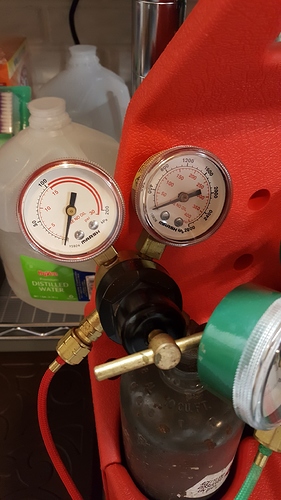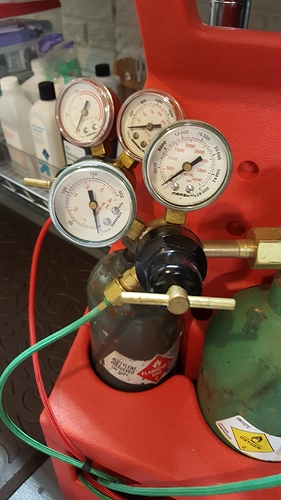Hello fellow Orchidians,
I am an amateur at best and do not like the black soot that ends up all over the studio when using the acetylene/oxy torch. So… I’d like to update my setup, if possible, rather purchase a new propane/oxy torch or continue using plain old disposable propane-only tanks. As much as they’re ok for some things, they’re not so great at others.
I searched the topic and did not find a definitive answer to my question; Can I simply swap the acetylene tank to propane (using appropriate adapters, of course) with my current setup? Several posters say, change the acetylene regulator others say the existing regulator will work with propane. Some say change out the the hoses, others say don’t bother if they’re “T” rated.
I’ve attached photos of my regulators and handset (FWIW) to illustrate exactly what I currently have. As I mentioned, some of the posts said if the existing hoses are “T” rated, they’ll be fine with propane, but I cannot find any notations on the hoses. As you can see these are the Smith Little Torch red and green covered versions (this is not a knock-off setup).
And some stated that using the existing regulator is fine as well when going from acetylene to propane (but not the reverse). I don’t have a problem getting a new regulator if it’s NECESSARY.
I appreciate any thoughts on the conversion.
Thanks!
Sharon in Iowa



 . He doesn’t use it so much anymore.
. He doesn’t use it so much anymore.


 Not sure about the brain damage part, but I did try to get used to it. Sadly I’m both not fast enough and still a little jittery when handling FIRE and the jittery part is compounded when I’m trying to be lightening fast with the lighting of the torch (using electronic strike). $15-30 isn’t all that bad to make the change…
Not sure about the brain damage part, but I did try to get used to it. Sadly I’m both not fast enough and still a little jittery when handling FIRE and the jittery part is compounded when I’m trying to be lightening fast with the lighting of the torch (using electronic strike). $15-30 isn’t all that bad to make the change… Seriously, I know I should be scared and conscious about what I’m doing and the need to be CAREFUL.
Seriously, I know I should be scared and conscious about what I’m doing and the need to be CAREFUL.